|
Last week I ran two games of Longstreet over two days, for two groups of players. The scenario was Blocher’s Knoll, which is on the scenario page here. I had written the original scenario 7 or 8 years ago but updated it for the latest outing, having read a bit more about Gettysburg in recent years. The scenario concerns Ewell’s assault on the Federal right wing just north of Gettysburg on 1 July 1863. Howard’s XI Corps is spread thin, facing north, from where Ewell’s Corps is approaching. Ewell, meanwhile, is marching down two converging roads, one of which points directly behind the Federal right flank. It is an opportunity to dislodge and roll up XI Corps. Game 1: “I was winning the battle at 4, but lost it by 5!” The first game pitted Dan and Harry’s Confederates against Spencer’s Federals. Spencer had three brigades of mainly cautious veterans (Pennsylvania Dutch, still smarting from their rough handling at Chancellorville), with Barlow’s division in front and Krzyżanowski in the second line. Dan led Early’s division on the left, heading for Spencer’s hanging right flank, while Harry kept Spencers attention from the front with Dole’s brigade. Spencer, who has a history of aggressive play, set out to spoil Dan’s attack with one of his own and to put pressure on Harry. Rather as one might expect, the cautious Pennsylvania regiments were just not suited for aggressive charges and bounced off the secessionists wherever they met them. However, a cautious veteran is still a veteran and they fought much better in defence. Losses mounted on both sides but the Confederate left hook developed well and when Blocher’s Knoll fell to Early, Spencer seemed perilously close to defeat. Spencer then got a break that totally changed the picture. In his enthusiasm to outflank the Federal position, Dan sent a regiment in march column over the bridge across Rock Creek, right under Federal noses. Spencer hit the march column with a big, seasoned regiment and almost wiped it out. In the victory step of his turn, he rolled high and the game was over. Longstreet’s victory conditions are a feature of the rules that I really like. They permit scenarios between unbalanced forces where the final issue may not be in doubt, but the weaker force can still win the game. Spencer had fewer numbers and poorer quality troops but he deservedly snatched victory from defeat when he punished Dan’s rashness. We agreed that had we continued playing, the Federals would soon have been rolled up by superior Secessionist numbers. It was a shame for Dan and Harry, who barely put a foot wrong until the march column/bridge incident. But somebody had to lose and they did so with good grace. Game 2: “More Troops? Where would you have me find more troops?”
Game two was a two player clash between Chris’s Federals and Ian’s Confederates. Ian attacked Chris’s left with Dole’s brigade, while he marched Early’s division down the other flank, deploying his artillery to cover Blocher’s Knoll from the east while Gordon’s brigade attacked from the north east. I did think this would be a game-winning attack and the rebel guns did some serious damage to the defenders on the knoll. However, three factors conspired against a Secessionist win: Chris sent a regiment over Rock Creek to fire into the flank of the rebel artillery, which didn’t so much damage as distract it from it’s main purpose; Gordon’s Brigade took too many losses to carry Blocher’s Knoll on its own; and Dole’s brigade got itself annihilated in an unequal struggle against the stronger Federal Left. While losses were high on both sides, Ian’s crossed the line first and Chris took the win. So the Federals won again. As with the first refight, it was inevitable that the next assault would have succeeded, but in game terms, the initial attack had been too costly for the rebels. Ian observed that at game’s end he had Avery’s and Hays’ brigades still fresh, drawn up behind the artillery, while poor old Gordon had marched up Blocher’s Knoll on his own. Ian also reflected that he need not have pressed the assault by Dole against the Federal Left: he could have pinned Chris in place by standing off, ready to advance if the Federals depleted their left to support the right. As ever, both games were great fun (for me, at least!). I am glad to have dipped back into Longstreet and hope to have made some converts to these subtle and engaging rules.
0 Comments
For the past few weeks Matt, Spencer, Dan and I have been playing a campaign based on Jackson’s Valley campaign in 1862. Matt is playing the man himself, Spencer is Federal General Banks, Dan is supplying instructions for devolved commands and I am umpiring and playing battles out where necessary on the tabletop. So far Banks has had the numbers and Jackson the speed. The map and play mechanics are explained in previous blog posts. To keep a bit of pace, each ‘turn’ the players provide orders for three impulses at a time. I then play these out, interrupting the turn to resolve clashes, either with simple dice rolls or, as has now happened twice, to fight a figure wargame. If a player’s character is ‘present’ at the battle I ask them for instructions. If they are absent, Dan steps into the role of the detached commander. The story so far I am having to delay these reports a little to keep the opposing generals in an appropriate state of ignorance. But the bones of the campaign so far are as follows. Banks began the campaign by sending half his army westwards out of the valley into the Allegheny mountains, then southwards to try to get around and behind Jackson’s army. The road net outside the valley is not good and so this movement took some time, during which the other half of the federal army sat tight at Strasburg. Jackson was alerted to the movement and in turn warned General Johnson, commanding the tiny Army of the North West in the Alleghenies, to block the Federal advance. Meanwhile Jackson withdrew his own small army southwards and took a portion with him to support Johnson. There followed the battle of Franklin, at which the Federal force, ably led by Dan, broke the rebel left and pushed them back on Harrisonburg and McDowell. The momentum then swung Jackson’s way. Unknown to Banks, Jackson was reinforced by Ewell’s division arriving from the east. While still outnumbered in the Valley overall, Jackson now had local superiority as well as the benefit of surprise. His odds further improved when Banks recalled part of his detached command to Strasburg, leaving the victors of Franklin only two brigades to continue their advance against Jackson’s left rear. In the next eventful turn, there occurred two significant combats, in both of which the rebels began with a marked advantage. Had the time come for Jackson to show his mettle? The Battle of Harrisonburg Following up on his victory at Franklin, Federal general Shields advanced eastwards into the valley. He caught up with Jackson at Harrisonburg, where he saw the rebels deployed on a line of three low hills west of the town. Shields’ role was once again taken by Dan, who planned to attack first on the right, then to close with his centre and left once his right wing had taken the leftmost rebel hilltop. This plan saved him from total destruction. His right wing advanced on the enemy hill, which was occupied only by dismounted cavalry. The rebel horse mounted and charged down from the hill into Shields’ cavalry, the combat continuing for a couple of turns on the far Southern flank of the table. As Shields’ leading regiment neared the crest of the seemingly empty hill, a line of Louisianans charged into view and bowled the federals back down the slope. It was Trimble’s brigade of Ewell’s division, freshly arrived to reinforce Jackson. At the same time Taylor’s brigade from the same division appeared round the side of the hill and charged towards the federal centre. The federal right was all but destroyed. Fortunately for Dan, his centre and left were still some distance from the rebel positions and so avoided being caught in the flank. They were able to withdraw, but the rebels pursued vigorously, obliging the Federals to detach a regiment of infantry, their last unrouted cavalry regiment and a section of smoothbore as a rearguard. Under the protection of this rearguard, the rest of the command fled westwards back to the Alleghenies. The brave rearguard was eaten up however and four cannon were lost. Post-match analysis I played Harrisonburg using Honour Games’ Longstreet. It was at the limit of the rules’ applicability: a couple more brigades and I’d have used On to Richmond. The mixture of random cards and orders from absent players worked well again. I felt sorry for Dan that he was walking into a trap but on reflection, that is the appeal of a campaign: surprise attacks are harder to set up in a one-off encounter. It was also an advantage that Dan wasn’t there in person. When a player gives up their time to play a face to face game, one wants to give them a fair chance of winning. In this case, the only question was how badly Dan would be beaten up. As it happened, his plan probably gave him the least bad outcome, since his initial attack revealed the rebel reinforcements before the rest of his army had advanced too far. When I sent him the news of the trap in mid-game, he supplied the orders for the rearguard defence, which again helped save men (at the cost of the rearguard and 4 cannon). He also didn’t seem to mind having been set up! Rebels everywhere While Shields was retreating in the south of the valley, a lone federal brigade at Front Royal was manoeuvred out of its position by superior rebel numbers. This brigade withdrew to Middleton in good order, to cover the road to Winchester. But it seemed at turn’s end that Banks’ position in Strasburg was at risk of encirclement. Remove me from this hell! I would say that fully half of the campaigns I’ve played in over the years have ended through a trailing off of interest rather than the achievement of a set objective. I don’t want this campaign to go that way. I have included the following text in the latest situation reports for both sides: “Many wargame campaigns don’t so much finish as fizzle out. They continue without a clear end point, until eventually one or both players lose interest. That will not be our fate! The historical campaign ended when troops in the valley were called away to take part in a major operation in Virginia. In game terms, I am now checking each turn whether that moment has arrived, at which point I will adjudicate the effect of the campaign on your personalities’ reputations. I want to be sensitive also to your ‘real world’ wishes. In submitting your orders you may express your preferences for continuing the fight in the valley or for requesting to join the impending operations in Virginia. These will affect the dice roll for campaign’s end.” I must say this small campaign has been fascinating, watching the player’s shadow box with limited knowledge of each other’s dispositions. I think both have several reasons to be pleased with their performance. I also think the campaign can still go either way, but the next turn or two should produce a decisive result.
Last weekend we had the first figure wargame within the framework of our Shenandoah Valley campaign. It took place at Franklin in West Virginia, between Shields’ Federal division of Banks’ army and Johnson’s Army of the Northwest, reinforced by Jackson and a brigade of his foot cavalry. Shields had been sent in an outflanking manoeuvre by Banks, played by Spencer. The mechanics of the game: playing with a split personality I played the game using Sam Mustafa’s Longstreet rules and my 12mm Kallistra figures. The 72 x 48 BW map came from a Google satellite map of Franklin WV. I drew on the historical orders of battle for the troops present. Matt, who is Jackson, was present and so gave me his instructions for the battle direct. As Banks/Spencer was not present on the field in person, I recruited Dan to provide orders for the Federal force. Each had a scenario briefing as if for a face to face game. Matt supplied general instructions for the Confederate side while Dan really went to town, with full instructions and four maps showing his intended dispositions and movements. Between them, the instructions from the players supplied all I needed to play the game in accordance with their wishes. The use of an action deck in Longstreet adds a random quality to solo play. I decided that the federals would hoard/play cards favouring attack and the rebels would use those with a more defensive benefit, - although I made sure to keep Rebel Yell cards for counterattacks. At the start of each turn, I checked what interrupt cards were in the passive player’s hand and rolled a die to see if they would be played this turn. This worked very well, - almost spookily in the case of the so-called “couldn’t hit an elephant” card which represents the enemy general being hit. The union side played this card at a key moment with devastating results, which was a parallel with the wounding of general Johnson at the battle of McDowell in the historical campaign. A brief account of the battle The rebels deployed along the south bank of Friends Run, which flows from west to east above the town of Franklin. Two batteries were entrenched on high ground to the left and certain infantry units were also behind light earthworks along the run. Johnson’s brigades were in the left and centre while Fulkerson was in reserve on the right. Most of Johnson’s Command were recruits while Fulkerson commanded two regiments of veterans. The Federals deployed their artillery on a ridge at the right of their position. Next to them was 2 brigade, in depth to the west of Petersburg Pike. Then came 1 brigade to the east of the pike, with cavalry at the far left, by the south branch of the Potomac. Each federal brigade was much bigger than a rebel equivalent and overall the Federals had significant numerical superiority, although they had no veteran units. The federal attack consisted of an advance in the centre by a line intended to engage the rebels with fire but not to assault. Meanwhile two assaults were made against the rebel wings, each containing two regiments, one behind another. Their cavalry was to try and get around behind the rebel right if the chance arose. In the event it failed in the face of cavalry on the rebel right. Overall, the rebel right and centre held and even counterattacked successfully against the left hand federal assault. On the rebel left however, the union assault rolled right over the front line, helped by the supporting fire from their artillery, which both reduced the Confederate infantry and made some successful counter battery fire. Just at the point when the rebel second line were poised to counter attack, general Johnson was severely wounded. (If you don’t know these rules, the ‘elephant’ card involves removing action cards from the victim’s hand. On this occasion the rebels lost 5 cards out of their hand of 6, which seriously restricted their options at this crucial juncture). This allowed the Federals to press their advantage and push their whole right wing over Friends Run while the rebels were off balance. The rebels could not restore their line and soon found their position unhinged by a federal force deep behind their left and in a position to roll up their position. One of Matt’s instructions was to preserve his troops as a force in being and as the federal position was now so favourable, I decided the rebels should withdraw now or face major losses. Fulkerson was still in good shape, so his brigade formed a screen behind which Johnson’s brigades retreated. The Federals tried to catch as many rebel units as possible and nearly cut off their retreat along the Pike but the rebels left the field in reasonable order. So the first battle has gone the Federals’ way. The players have received their status reports and I am waiting for their orders for the next turn. Dan has won his place as go-to surrogate for future games in the campaign. For my part, I spent two very happy days in the shed, remembering just how much I love these rules. I also realised you can never have too much split rail fencing, so have started work on some new lengths in preparation for the next round in the campaign.
I think the time lag is enough to report on the opening moves in our Lockdown campaign, based on the Shenandoah campaign in 1862. We began with Union General Banks in Winchester and Stonewall Jackson a bit further down the valley at Mount Jackson. The federals began with a big numerical advantage but the rebels had a significant edge in cavalry, which combined with a local population that is mostly friendly means the rebels had good intelligence on the Federal forces. Matt and Spencer know each other’s playing style well and they went in for some interesting second-guessing. With two divisions, each significantly larger than the whole rebel force, Spencer sent the forward-most one (Shields) westwards from Winchester into the Allegheny mountains, intending to outflank Matt and enter the Valley from the South West. Meanwhile his second division (Williams) advanced down the Valley Pike, in order to locate and fix Jackson in place. Matt on the other hand suspected Spencer would try a flanking move and sent one of his brigades westwards along a parallel road into the Alleghenies. Meanwhile he withdrew with another brigade to Newmarket where his troops began to dig in. In the first turn both commanders tried to make contact with their sister commands in the Alleghenies, who were Frémont, commanding Federal forces and Johnson leading the rebels. I ran both as non player characters, drawing on a bit of chance combined with their historic performances. The upshot was ready agreement from Johnson to cooperate with Jackson, whereas Frémont declared his readiness to work together with Banks but was very slow mobilising his force. At the end of the turn Jackson received news that General Early was expected in the valley within a couple of turns. Turn 2 saw Matt changing his mind about his move westwards and recalling his flanking brigade. This about face nearly lost him the brigade as Spencer had ordered Williams to march south and take Strasburg. Williams vey nearly caught the returning rebels on the road and would have done so, had it not been for the presence of rebel cavalry to slow down the Federal advance. Fortunately for Mattt, Williams’ force had no cavalry of its own in the vanguard, which added to the efficacy of the rebel rearguard. The returning brigade squeaked through and out of Strasburg while Williams was still held up north of the town. Meanwhile out west, Shields advanced down the Alleghenies towards Franklin, where Johnson was digging in with his small army. Frémont, bless him, made no move to support Shields. The dice were helping the wargame Frémont to behave much as the real man did: with the energy of a slug. So the second turn/sixth campaign day ended with an apparent stand off in the valley and a battle imminent in the Alleghenies. Umpiring the campaign
In a few cases so far I have had to establish who got the better of a skirmish or whether a brigade could escape the jaws of a trap. For simplicity, I have rolled competing dice on behalf of the two sides and the result has gone the way of the higher scorer. The bigger the margin, the more emphatic the success. For even chances I have compared the rolls of two D6. If one side has an advantage, such as superior numbers, better training or a proactive leader, that side rolls a D8, D10 or even D12, depending on how many advantages affect the matter. I also use a competing die roll to see if a non player character complies with a player’s request. So far this approach has worked ok. For the impending battle of Franklin, I will fight it this weekend using Sam Mustafa’s Longstreet rules. One player’ character is present on the battlefield so he has given me his orders for the battle. As the other is absent, I have recruited Dan to act as the detached general and he has submitted a full set of instructions complete with maps. We shall see how it all pans out. Three weeks into the Covid 19 lock down, I am making progress on some gaming projects. I have been painting more 6mm Napoleonic figures for a multiplayer Lasalle scenario later in the year (Lord knows when!) and then plan to rebase my oldest collection of figures, two 6mm armies for the War of Spanish Succession. While these are quite satisfying solitary chores, I miss actually playing games. So last week I floated the possibility of a small campaign with Spencer and Matt. They were ready to indulge me and I started looking for a theme. I have run only three campaigns in the past: two set in classical Greece and one in the American Civil War. Matt, Spencer and I play a lot of Ancients and I kicked around a couple of options, one set before the rise of Philip of Macedon and one in Sicily. Neither got me excited enough to turn the idea into a game. Turning to the ACW, I recall playing an enjoyable short campaign in the early 1980s with my friends Keith Blackmore and Andy Finkel. The idea of an ACW campaign grew on me. I have played ACW since the 80s, both figure and board games, and have good source materials with maps and orders of battle. I particularly like the mechanics of A House Divided, Frank Chadwick’s strategic game with a map consisting of a network of boxes connected by different forms of road (the game is still available, now published by Mayfair Games). So ACW it is! As for subject, I decided on the Shenandoah Valley in 1862 as a great candidate for a limited but interesting game. Now, the aim of many wargame campaigns is to lead to face to face games. That isn’t going to be an option for now of course so I want the map turns to be engaging in themselves. As umpire, I hope to encourage a bit of role playing, assisted by some messages from non-player characters. When opposing troops collide, we will play it by ear. I can resolve small encounters with a dice roll. For larger engagements I have Longstreet for brigade level games and On to Richmond for bigger encounters. We shall have to work out how much the players will be involved in table top battles. We can cross that bridge when we get to it... I started with the map, mainly based on the National Geographic Atlas of the ACW and the Osprey Campaign book, Shenandoah Valley 1862 by Clayton and James Donnell. I decided to copy the connected boxes idea used in ‘A House Divided’. I added a wrinkle from another Frank Chadwick game, Attack in the Ardennes, in which the different road types limit the number of units that can travel between two boxes in a turn. This brings out the importance of the major roads and junctions and poses tricky choices to a commander: do they keep their forces moving slowly together, or move fast and get strung out across several boxes? What happens if they meet the enemy in this state? I started the map on a drawing app but found this too fiddly and so resorted to the old standby of pens and gridded paper. I spent a happy day with rulers, eraser and coloured pencils and ended up with an unattractive but, I hope, serviceable game map. The campaign rules shared with both players are below. In addition to the common rules, each player had a personal briefing, with their own campaign objectives and order of battle. I won’t share these yet as both players read this blog (or they pretend to!). As of today, the first turn has completed and the players have submitted orders for turn 2. I don’t know if they are enjoying it yet, but I am already Having a ball! ACW Campaign rules: Fire in the Shenandoah, March 1862 Introduction The Shenandoah Valley is a picturesque and fertile farming region, bounded by the Allegheny Mountains to the west and the Blue Ridge Mountains to the East. Its axis runs from South West to North East, and it is divided down the middle by its own range, the Massanutten mountains. In 1862 possession of the valley offered advantages to both North and South. For the Confederacy the valley was a vital source of supplies, especially of grain. Also Harpers Ferry at its north east tip, only a short distance from Washington DC, was a potential jump off point for invading the North. For the Union, possession of the valley could deny the vital food supplies to the Confederate army, cut the railroad from Richmond to Tennessee and threaten Richmond from the West. The campaign began in late February 1862, with an invasion from Harper’s Ferry by a Union army led by general Nathaniel Banks. Heavily outnumbered, Confederate general Thomas “Stonewall” Jackson withdrew down the valley, while calling in his reserves. It is now mid March. Banks is at Winchester, getting ready to bundle Jackson out of the valley completely. Jackson is somewhere down the valley, waiting for the storm to break. Common rules The Map The map is of the Shenandoah Valley, overlaid with boxes connected by a road net. All units occupy boxes and move between them along the road net. There are four types of road: Pike, Road, Track and Railroad. Most boxes are clear terrain but some have a river along one or more sides (blue shading) and others have difficult ground (brown shading). Boxes surrounded by mountains are considered difficult ground The turn One turn consists of 3 impulses. Turns are resolved simultaneously by the umpire. Orders The players submit orders at the start of each turn. You must provide an order for each of the 3 impulses. A unit without orders will stand in place. Orders can be:
Movement and stacking Space: You may only occupy named boxes on the map. You may have as many units together in one box as you wish. Roads: Every connecting road has a maximum capacity of units that can travel along it in one impulse. The maximum number of infantry units that can move along a connection in one impulse are: Turnpike(double line): 4 units Road(single line): 2 units Track(dotted line): 1 unit Railroad(hashed line): unlimited units as long as railroad is friendly. If it belongs to the enemy, it counts as a road. NB Cavalry does not count towards this limit. Thus, in one impulse, you could send 2 infantry units plus one cavalry unit along a road. A unit may move in every impulse of the turn but this could cause fatigue and attrition. Note that, as there is a limit to the number of units that can use a road in an impulse, it could take two or more impulses for a larger army to move from one box to the next. (Example: a force of 3 infantry units wants to move along a road from one box to another. As only two units can use a road in one impulse, it would take two impulses for the whole force to end the turn together in the destination box. The order might read: 1st unit: move from Staunton to Harrisburg; rest; rest 2nd unit: move from Staunton to Harrisburg; rest; rest 3rd unit: rest; move from Staunton to Harrisburg; rest) To recap: it is possible to move up to three times in a turn but this is likely to result in a unit becoming fatigued. Also, if a large force moves fast using roads or tracks, it is likely to end the turn strung out between more than one box. Encountering the enemy If you enter a box containing enemy troops there will be an encounter. Cavalry on its own will retreat from moving enemy units if outnumbered, unless specifically ordered to stand and fight. Other troops will act in line with any prior instructions from their commander: to stand and fight; conduct a fighting withdrawal or attempt to retreat without fighting. If you, the player character, are present at the encounter, you will be given information about the situation and asked for your orders. If we can manage it and the battle is big enough to warrant the effort, Tim will arrange to fight the encounter at a time when you are available, so you can be involved via Skype or WhatsApp as the battle unfolds. If you, the player character, are not present at the encounter, you will receive a report afterwards of how it went. Terrain Some boxes have either a blue or a brown shading along one or more side, representing either a river or difficult ground. If you occupy one of these boxes and the enemy enters the box across a shaded side, you will receive advantages in the combat. Boxes in the mountains at the left or right side of the map contain difficult ground that is generally favourable to the defender. Boxes in the valley are open terrain, except where a side is shaded brown or blue as noted above. If infantry is present in a box for some time it can prepare the ground, which will be an advantage in battle. To prepare the ground, a unit must spend a full turn (three impulses) doing so. Note these are not like the trenches developed later in the war, but are light fieldworks. Scouting and screening Cavalry’s greatest use is to scout ahead and to screen your army from enemy attention. If Cavalry on its own enters a box containing only enemy infantry, it will retire back one box but can report to you the troops that it sees. If there is enemy cavalry in the box there will be a skirmish. If your cavalry win this skirmish it can report to you all the troops that are in the box. If it loses or the skirmish is inconclusive, it will retire back one box and will only report that it has encountered enemy cavalry. You are permitted to ask the local civilian population what they know about enemy movements. Note that the population are mostly pro-Confederate so their intelligence might be more reliable when dealing with rebels. In addition to the common rules, each player had a personal briefing, with their own campaign objectives and order of battle. I won’t share these yet as both players read this blog (or they pretend to!).
The first turn has completed and the players have had their status reports. I don’t know if they are enjoying it yet, but I am already very excited! While in Devon last weekend I played a game laid on by Keith, my ancient and constant wargaming opponent. He had set up a scenario for Longstreet, adapted from Warlord Games’ Glory, Hallelujah! ACW supplement, in which a Federal force of two divisions has the job of capturing a Confederate-held riverside fort, itself supported by two field brigades. I think the original scenario is called Wright’s Farm. I took the Confederates and Keith the Federals. Both of our break points, based on my outnumbered force, was 44. If Keith captured the fort, it would be worth an additional die towards rolling for my demoralisation. Keith had the option of bringing a steamer down stream to bombard the fort, although this would bring it in range of my heavy guns. Keith set up on a chain of hills overlooking the fort. I put a regiment in garrison with four heavy rifled artillery pieces in the fort on my left. The valley between the fort and the hill in my centre was filled with an entrenched regiment, then I placed one brigade in the centre and the last on high ground on my right. The frontages of our two forces were therefore about equal at the start, although Keith was deployed in more depth. In summary, the game began with Keith marching out all along his line, with a little more pace on his two flanks. His right wing assaulted the fort three times and each attack was repulsed. On his left, shortly before his line came within small arms range, I withdrew my right hand brigade and started moving them to reinforce my centre and left. I wanted the Union left flank to land its punch into mid-air and then be too far away to affect the fight for the fort. This nearly worked perfectly except Keith played a Confusion card on my rearmost regiment, which allowed him to catch and maul it. Apart from this I was pleased with the timing and execution of the withdrawal. In the centre, Keith’s initial intention had been to screen but he attacked four of my regiments at the same time as his last assault on the fort. This turn increased my losses but my line held. Shortly after, a very successful round of Confederate shooting pushed Keith over his morale limit and the game ended. The steamer never arrived to bombard the Confederate shore. This was a tense and fun game. I didn’t fancy my chances at the start since I was so heavily outnumbered but the fort was tough and I was able to inflict a lot of damage on the assaulting troops as they closed. As ever, the Longstreet cards dealt some memorable incidents that few other rule sets can allow unless they have an umpire. Foremost was the catching of my retreating right wing, which I would not have allowed to happen without the interference of an Interrupt card. Keith also inflicted a ‘couldn’t hit an elephant’ card (ie general hit by enemy fire) that removed 5 cards from my hand in one terrible turn. The Longstreet cards are a finely balanced device, keeping uncertainty high but never overwhelming the mechanics with too much arbitrary luck. Throughout a game, you still play your opponent rather than the system. I have said this before and it is still true: Longstreet is my favourite rules set, for any period. These simple, taut and flavour-filled rules are just masterful. Longstreet is quite hard to come by these days, at least in the UK. That said, the introductory rules and cards are still available to download for free on the Honour Games website. The combat rules are only slightly less comprehensive than the main rules, although they lack the campaign system. But the free rules and cards are still a great starting point. The figures were from Keith’s 15/18mm collection, mostly by Peter Pig. Buildings by Timecast and cloth by Cigar Box Battles.
|
Archives
November 2023
Categories
All
|
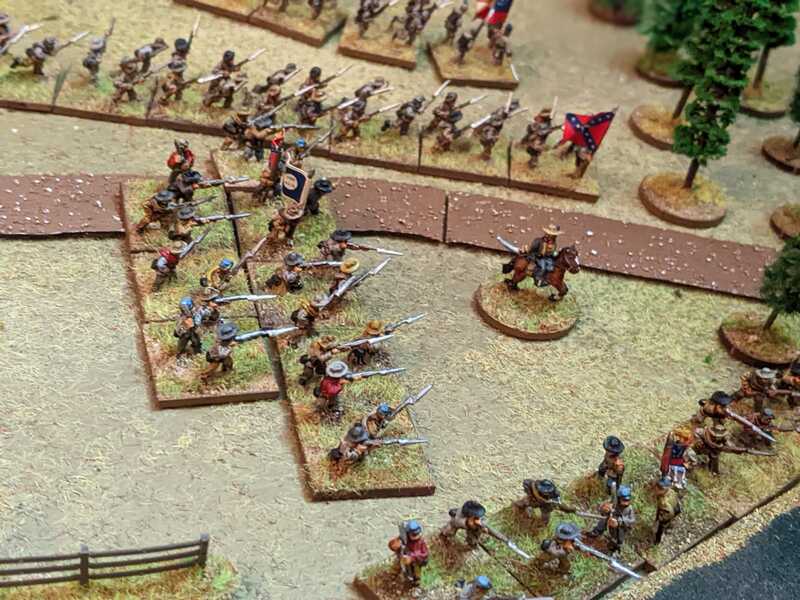


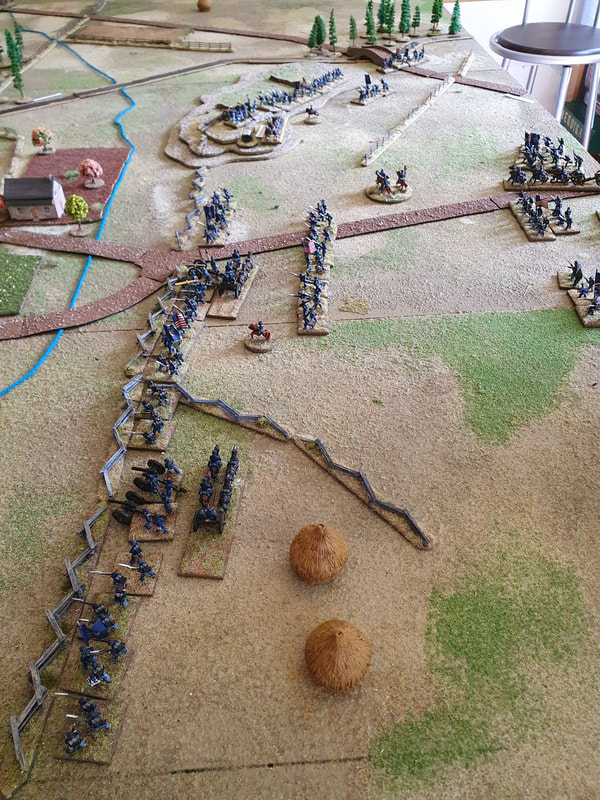
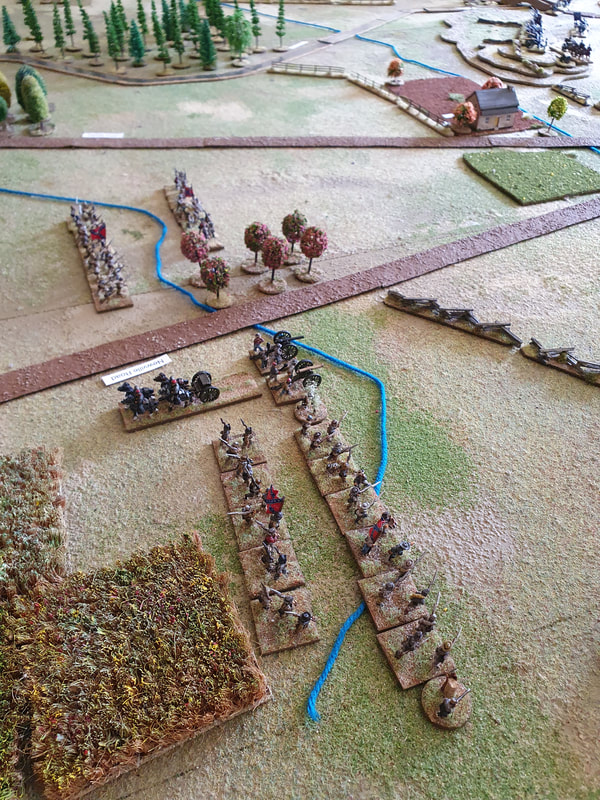

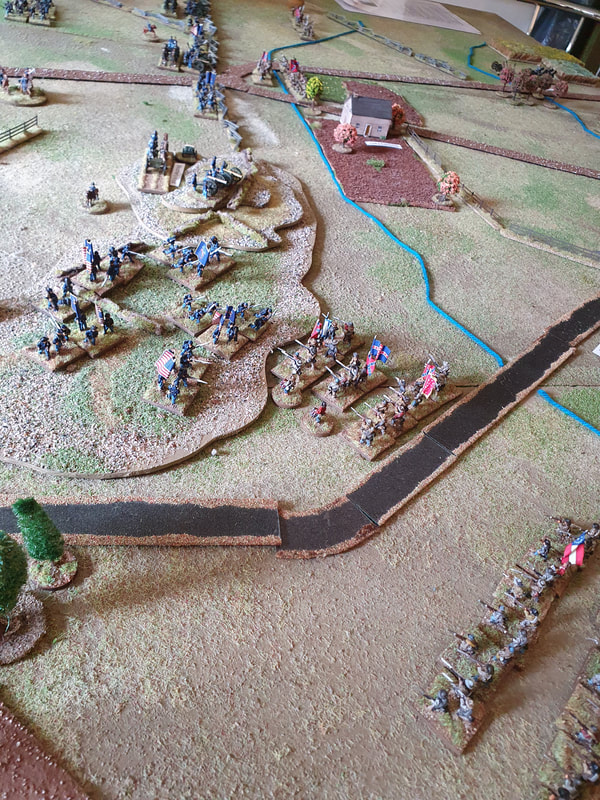
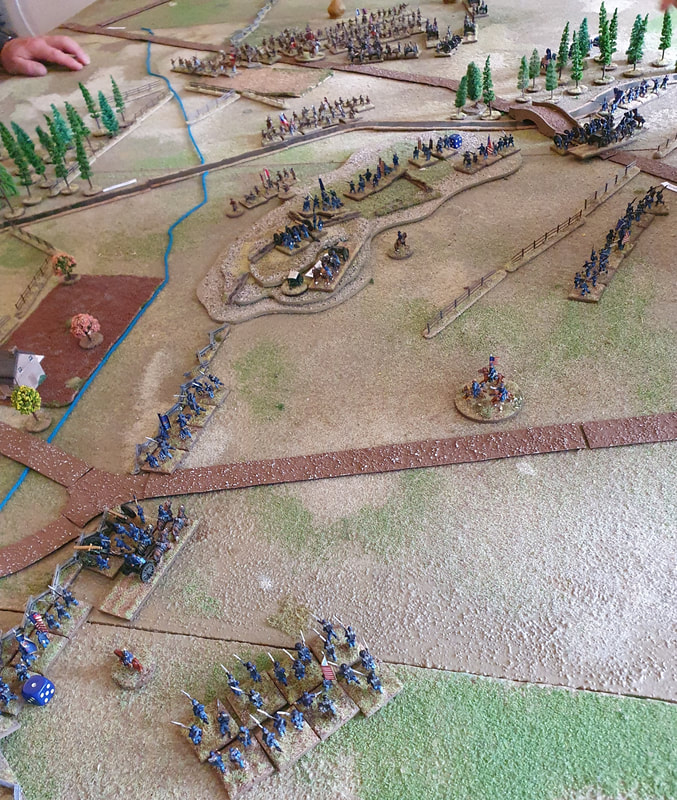
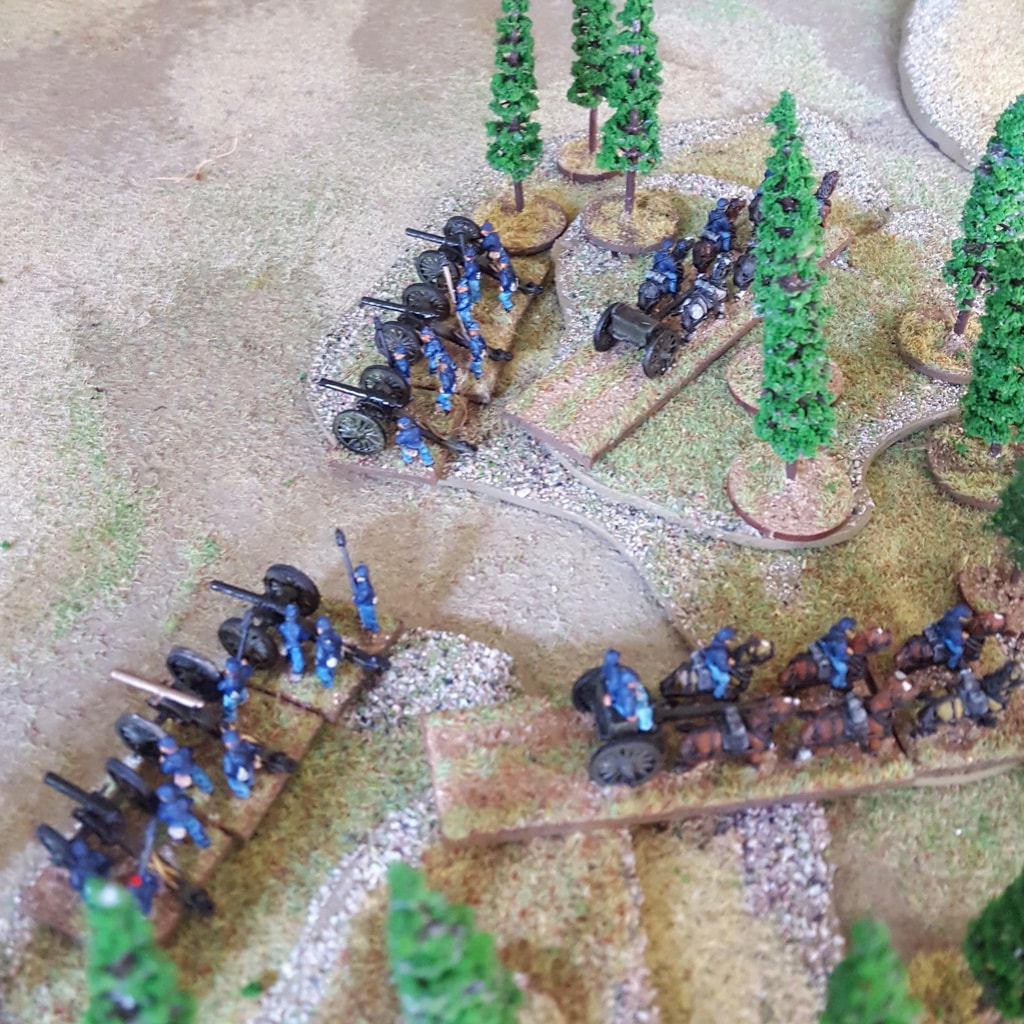
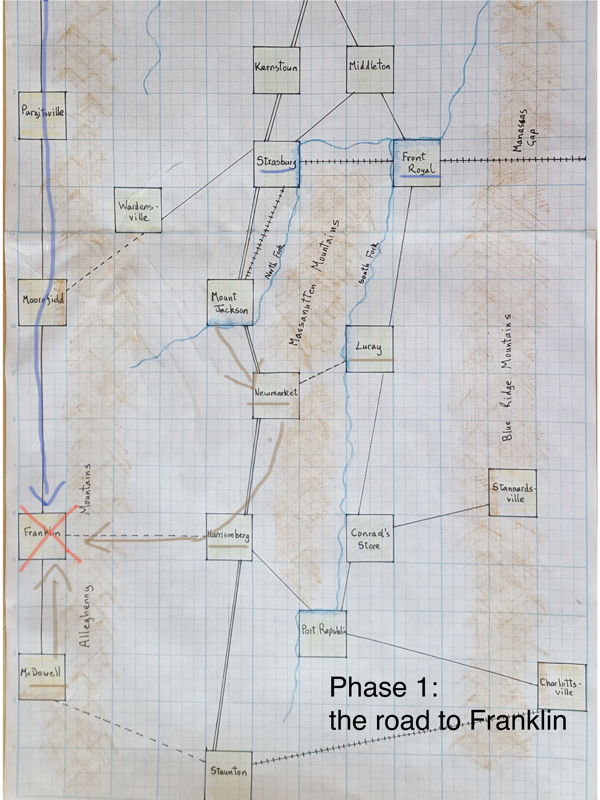
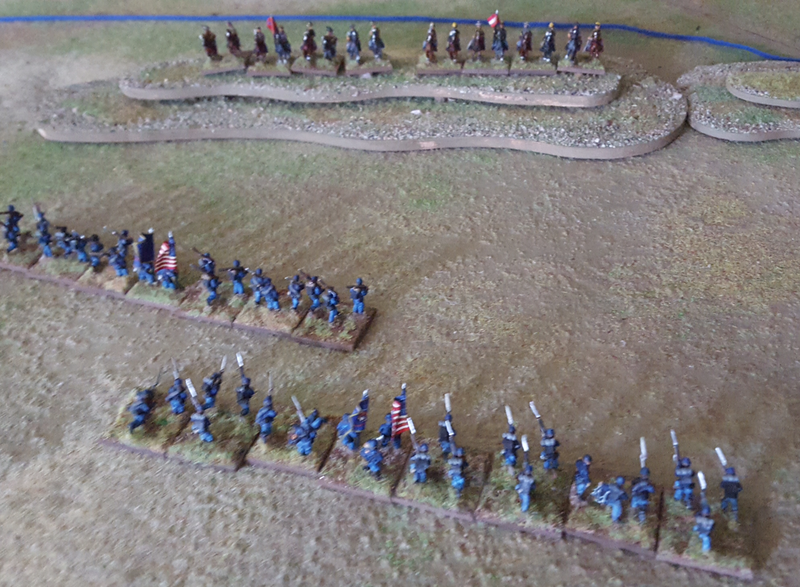
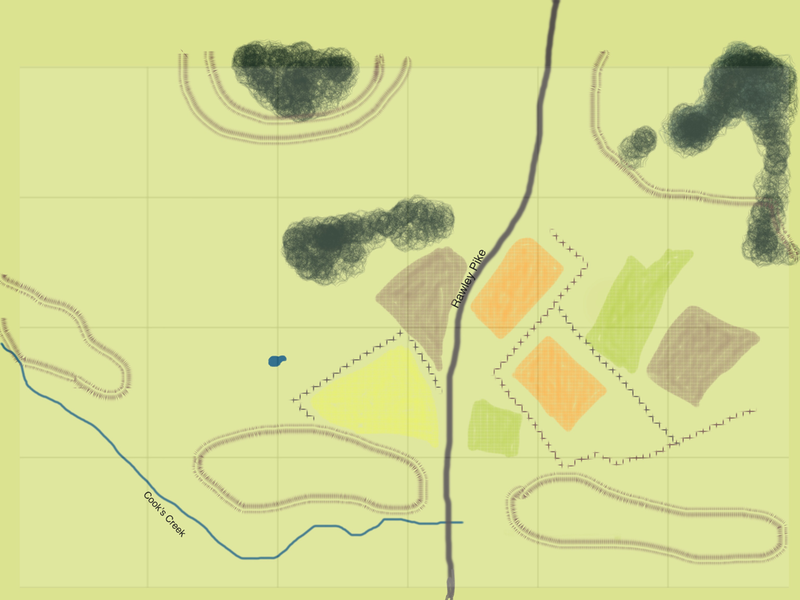

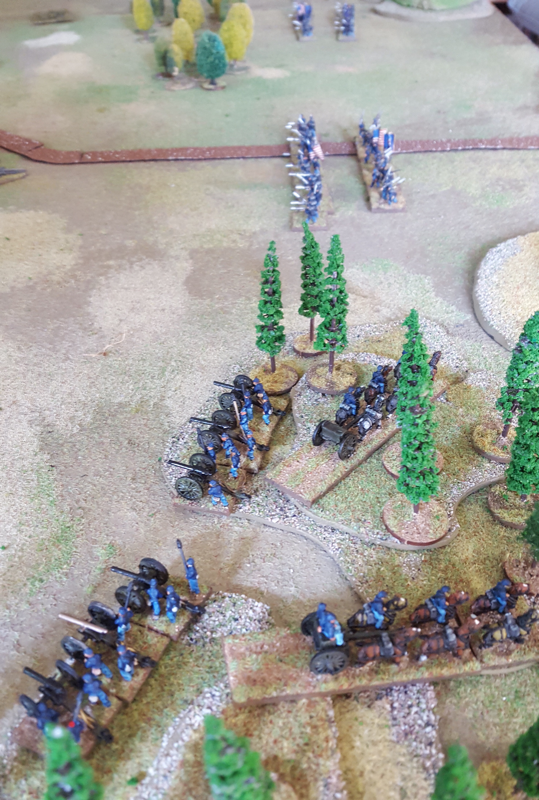


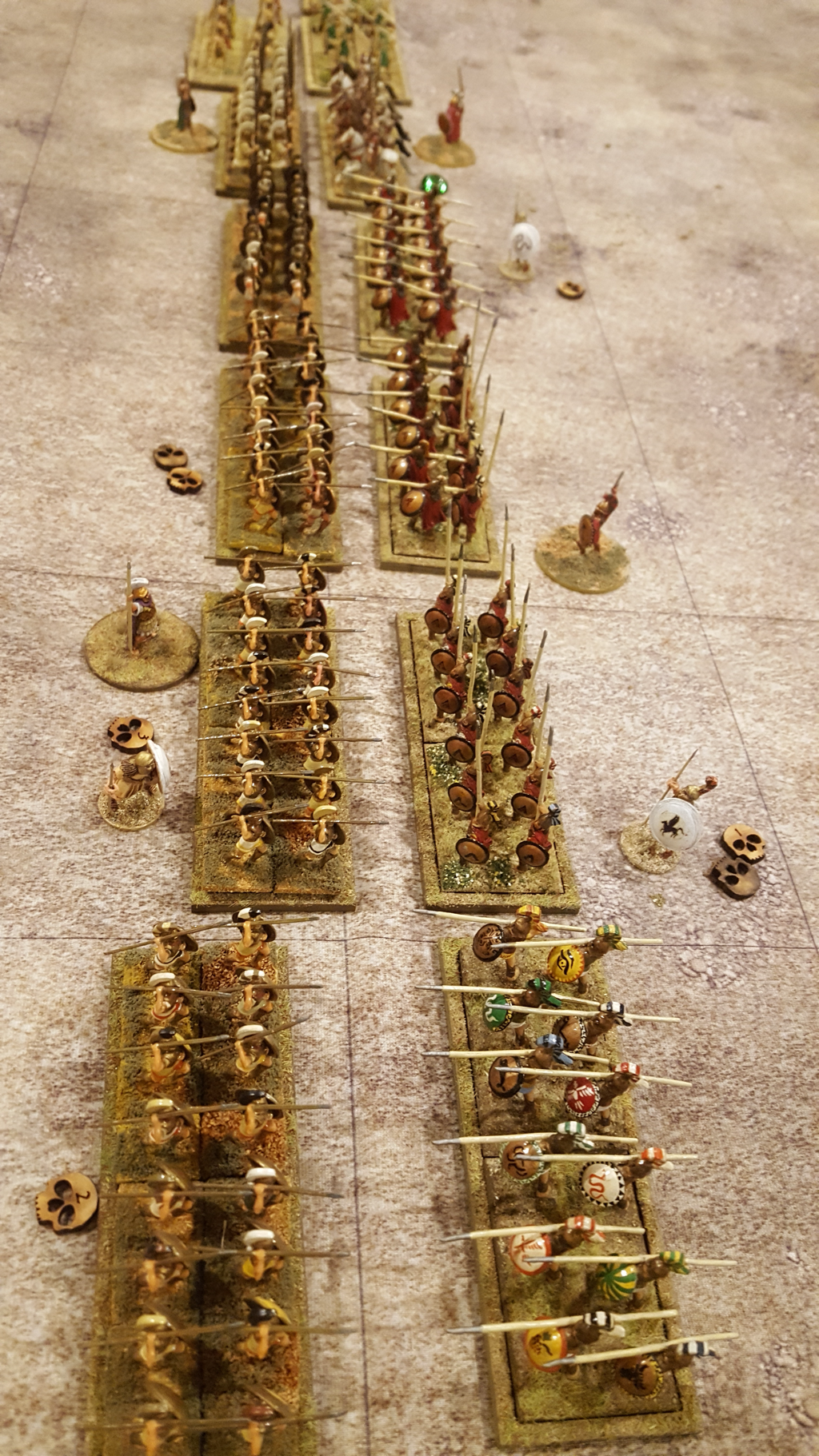


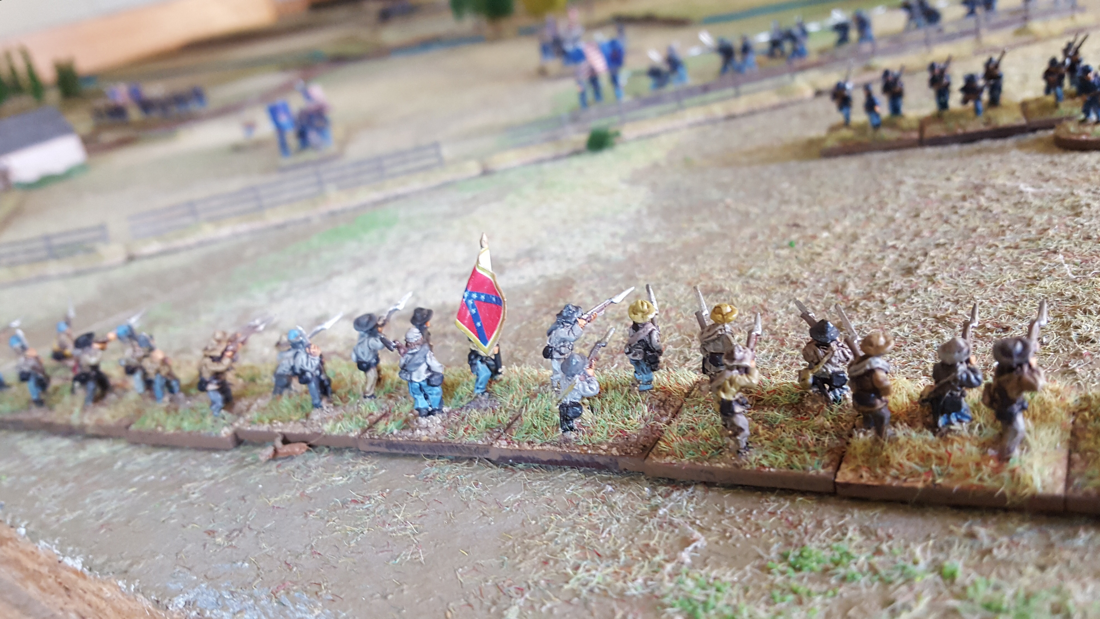



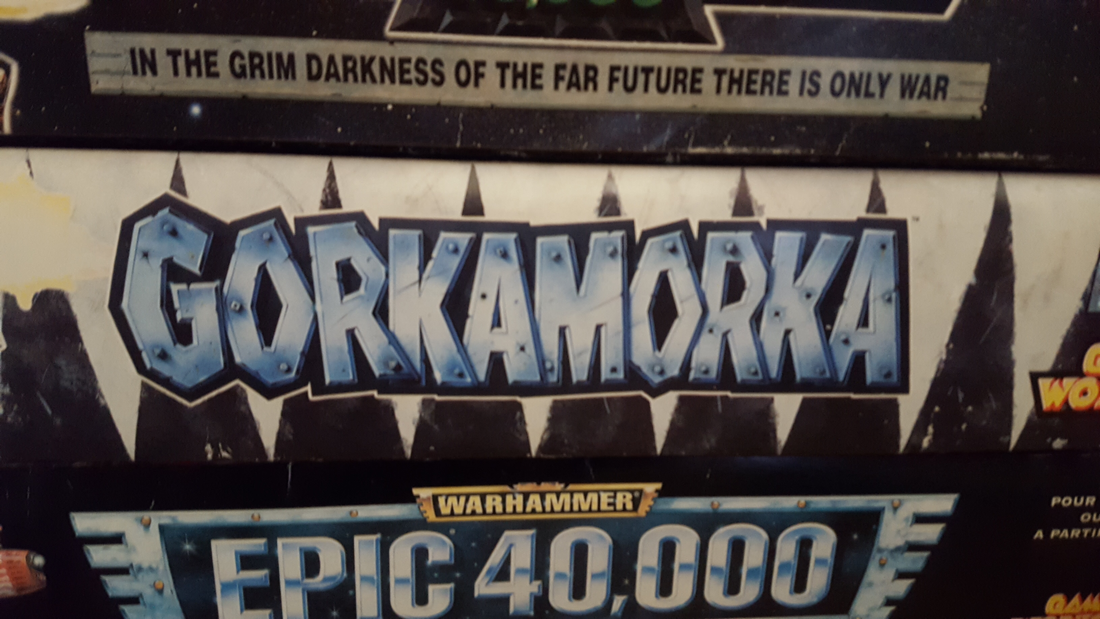







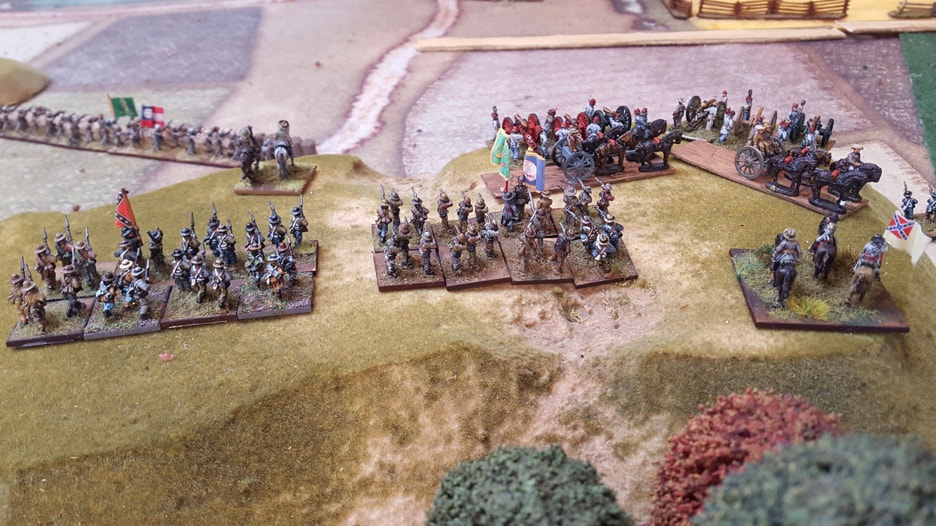
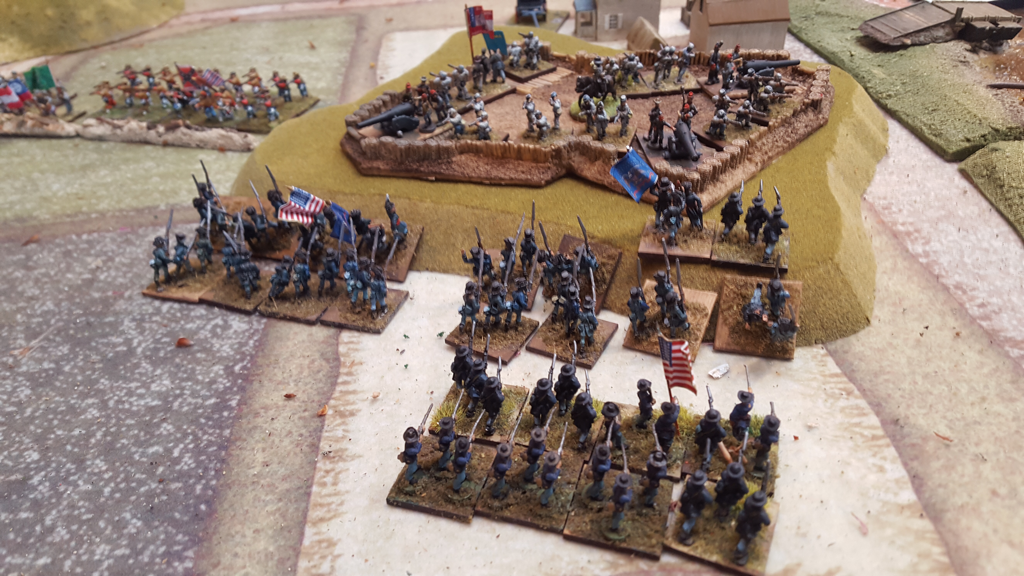

 RSS Feed
RSS Feed